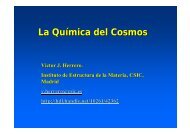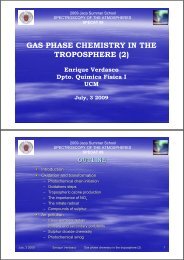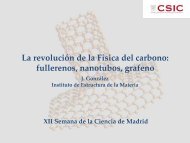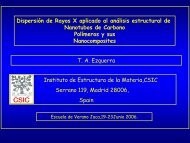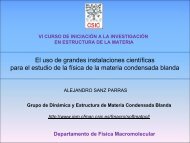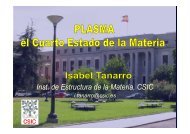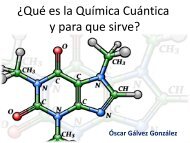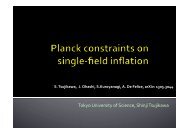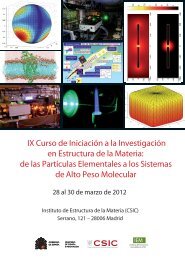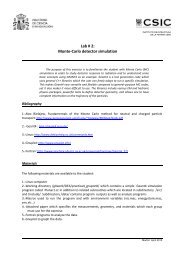oppositely aligned spins. This pairing gives rise to properties simi<strong>la</strong>r to superfluid helium and superconductivityresulting from paired electrons in con<strong>de</strong>nsed matter physics. In the structure that has been i<strong>de</strong>ntified in the pal<strong>la</strong>diumisotope 92 Pd, the neutrons and protons couple into a system of spin-aligned pairs, leading to completely differentproperties compared with what is found in ”normal” atomic nuclei. The interpretation of the experimental data hasbeen provi<strong>de</strong>d with the aid of microscopic nuclear shell mo<strong>de</strong>l calcu<strong>la</strong>tions. These calcu<strong>la</strong>tions suggest a completelydifferent picture for the heavy self-conjugate nuclei to what has been proposed in earlier theoretical mo<strong>de</strong>ls ofneutron-proton pairing. The results of this experiment have been published in <strong>2011</strong> in Nature (B. Ce<strong>de</strong>rwall et al.).MAGNETIC MOMENT MEASUREMENTS WITH STABLE (UNILAC, GSI) AND EXOTIC, NEUTRON-RICH (REX-ISOLDE) ION BEAMSMagnetic moments are a sensitive probe of single-particle properties in nuclei. They can be measured by observingthe perturbation introduced by a magnetic field on the angu<strong>la</strong>r corre<strong>la</strong>tion of gamma rays emitted in the <strong>de</strong>-excitationof the nuclear state of interest. Magnetic moment measurements were of paramount importance in the <strong>de</strong>velopmentof nuclear structure, and they were and are still essential to test the predictive power of the nuclear shell mo<strong>de</strong>l. In<strong>2011</strong> we published the results of state-of-the-art measurements of excited state magnetic moments in stable tinisotopes using the transient field technique (TF) in combination with Coulomb excitation in inverse kinematics (A.Jungc<strong>la</strong>us et al., PLB; J. Walker et al., PRC; J. Walker, PhD thesis, Universidad Autónoma <strong>de</strong> Madrid, May <strong>2011</strong>).The g factors of the first excited 2 + states in a series of Sn isotopes, <strong>de</strong>termined with unprece<strong>de</strong>nted precision,allowed to discriminate between a number of different mo<strong>de</strong>rn shell mo<strong>de</strong>l approaches and thus shed light on the<strong>de</strong>velopment of collectivity in the semi-magic chain of Sn isotopes.While the TF technique is well established in conjunction with stable ion beams the <strong>de</strong>velopment of radioactivebeams, while extending the domain of investigation to exotic nuclear realms very far from the line of stability, posenew experimental challenges. Our group accepted these challenges and inten<strong>de</strong>d to overcome certain inherentlimitations thanks to the construction of a new, purpose built, state-of-the-art reaction chamber, which was<strong>de</strong>veloped and built at IEM-CSIC. The new chamber harbors the external coils and yoke to produce the 80 mT fieldrequired to magnetize the ferromagnetic Gd target <strong>la</strong>yer and a liquid-nitrogen cooling circuit to keep its temperaturewell below the Curie temperature. In November <strong>2011</strong> A. Jungc<strong>la</strong>us, A. Il<strong>la</strong>na, A. Perea, J. A. Briz and R. Or<strong>la</strong>ndi, incol<strong>la</strong>boration with researchers from other European research institutes, run the first part of the experiment IS483 atREX-ISOLDE, CERN, aimed at measuring the magnetic moment of the first excited 2 + state in 72 Zn. The obtaineddata are currently being analyzed by A. Il<strong>la</strong>na in the frame of his PhD work and the experiment will be completedwith the remaining shifts in 2012. This pioneering measurement should permit to test the best avai<strong>la</strong>ble <strong>la</strong>rge-scaleshell mo<strong>de</strong>l calcu<strong>la</strong>tions which <strong>de</strong>scribe this region of the nuclear chart.REFLECTION ASYMMETRY IN LIGHT-ACTINIDE NUCLEI USING THE GAMMA-RAY TRACKINGARRAY AGATAReflection asymmetry and octupole <strong>de</strong>formation are well established nuclear properties and have been observed inmedium to heavy nuclei across the whole nuclear chart. On this topic, we participated in an experiment at theLaboratori Nazionali di Legnaro (Legnaro (PD), Italy) in March <strong>2011</strong> to characterize new structures observed in theoctupole-<strong>de</strong>formed light-actini<strong>de</strong> nuclei 220 Ra and 222 Th. The main goal of the experiment was to measure the linearpo<strong>la</strong>rization of gamma transitions linking new, unpublished rotational bands to the ground-state band. Thisexperiment ma<strong>de</strong> use of the AGATA <strong>de</strong>monstrator, an array of five triple cluster highly segmented germanium<strong>de</strong>tectors, which offers unprece<strong>de</strong>nted sensitivity, resolution and efficiency by exploiting its tracking capabilities.The gamma-ray interaction positions within the AGATA <strong>de</strong>tectors can be used to reconstruct the scattering angles ofthe transitions of interest, and hence <strong>de</strong>termine their linear po<strong>la</strong>rization. In this context it is also worth mentioningthat in <strong>2011</strong> the AGATA col<strong>la</strong>boration, the experimental nuclear physics group of the IEM is member of, reviewedall the achievements ma<strong>de</strong> in the AGATA project in recent years including all the necessary infrastructure to operateand support the spectrometer in an extensive (33 pages) article published in Nuclear Instruments and Methods A.R+D FOR THE R3B EXPERIMENT AT THE FUTURE FAIR FACILITYThe experiment R 3 B is part of the first phase of the FAIR facility. The experimental configuration of R 3 B is<strong>de</strong>signed for the <strong>de</strong>tection in complete kinematics of the products emitted in reactions at re<strong>la</strong>tivistic energies. TheCALorimeter for In-Flight gammA <strong>de</strong>tection (CALIFA) will be situated around the reaction target and should beable to reach the necessary angu<strong>la</strong>r and energy resolution to <strong>de</strong>tect gamma casca<strong>de</strong>s of 1 to 10 MeV with a strongDoppler broa<strong>de</strong>ning and Lorenz boost as well as to <strong>de</strong>tect protons of up to 300 MeV energy.Our R&D work concentrates on <strong>de</strong>velopments for the CALIFA gamma and proton spectrometer. We have within thecol<strong>la</strong>boration conclu<strong>de</strong>d the <strong>de</strong>sign of the Barrel part of the CALIFA calorimeter and a Technical Design Report(TDR) was, in December <strong>2011</strong>, han<strong>de</strong>d in to the FAIR management for evaluation.58
The Madrid group has in 2010-11 <strong>de</strong>veloped, in col<strong>la</strong>boration with the company Mesytec a Temperature and Biascontrol of the preamplifier stage in or<strong>de</strong>r to cope with the very sensitive LAPD light collection dio<strong>de</strong>s. The preamphas been further adapted to handle the huge dynamic energy range to be covered using the Time-Over-Thresholdmethod. The full system has been <strong>de</strong>signed to fit with the specific crystal encapsu<strong>la</strong>tion and the boards modified sothat the preamplifiers with the temp and bias stabilisation are directly fitted onto the crystals.In the <strong>de</strong>sign of CALIFA's forward end cap an innovative solution using two scintil<strong>la</strong>tors crystals stacked together,one after the other, in a so called Phoswich configuration with a common readout is being consi<strong>de</strong>red, see the 2010annual report. The experiments using this first LaBr-LaCl Phoswich <strong>de</strong>tector are now fully analysed and the resultfits perfect with the GEANT4 simu<strong>la</strong>tions we have performed, a NIM article, “A high ResolutionPhoswich:LaBr 3 (Ce) coupled with LaCl 3 (Ce)” is in preparation. Based on these results we have simu<strong>la</strong>ted, <strong>de</strong>signedand constructed a CEPA <strong>de</strong>monstrator consisting 2x2 crystal cluster of 4 cm long LaBr 3 (Ce) coupled with 6cm longLaCl 3 (Ce) crystals in Phoswich configuration. This <strong>de</strong>tector was <strong>de</strong>livered in December <strong>2011</strong>, and is now beingmounted in a specially <strong>de</strong>signed support structure, see the figure. During 2012 a full characterization and evaluationof this Phoswich approach will be performed.The CEPA(CALIFA Endcap Phoswich Assembly) <strong>de</strong>tector mounted on a methacry<strong>la</strong>te table support for itscharacterization in the <strong>la</strong>boratory. On the right, a zoom of the pieces that contitutes CEPA. As seen the <strong>de</strong>tector ismounted on a vacuum f<strong>la</strong>nge so it can be used together with our particle <strong>de</strong>tectors.Focusing on the end-cap, IEM group has been working on the overall <strong>de</strong>sign of the end cap to obtain a perfectadaption to the CALIFA barrel. This <strong>de</strong>sign is in<strong>de</strong>pen<strong>de</strong>nt of the final choice of crystal material. This <strong>de</strong>sign isma<strong>de</strong> so that the front-end cap, CEPA, can work as a stand-alone <strong>de</strong>tector and on the same time be fully integratedinto the Barrel. The <strong>de</strong>sign goal is a perfect adaption to the barrel, with minimum <strong>de</strong>ad material and a minimumnumber of overall crystals (each crystal ad an electronic chain) as well as a minimum number of crystal types (foreach type of crystal one will have to pay for the “mask/<strong>de</strong>sign” to the company). As the end cap is the lid of thebarrel it has the shape of a circu<strong>la</strong>r disc. In its present <strong>de</strong>sign it is formed by 750 crystals grouped in 10 equal“packages” of 75 crystals separated into 5 alveoli of 15 crystals. Further, as the crystal size along the po<strong>la</strong>r anglehas to match with the effect of the Lorenz boost on the gamma rays emitted in flight, it is natural to divi<strong>de</strong> the discinto ring segments. Every ring has a different po<strong>la</strong>r direction <strong>de</strong>pending on the energy resolution <strong>de</strong>ci<strong>de</strong>d (k=3.75%). The geometry of the crystals are rectangu<strong>la</strong>r pyramids with truncated bases with their edges <strong>de</strong>pen<strong>de</strong>nt on thepo<strong>la</strong>r angu<strong>la</strong>r change (frustrum-shaped crystals), so that it is adapted to the energy uncertainty associated to the γLorentz transformation characteristic of re<strong>la</strong>tivistic velocities of the gamma radiation. The total <strong>de</strong>ad volume(including wrapping) is 15 %.BEAM DIAGNOSTICS STUDIES FOR HIE-ISOLDEThe Dr. Francesca Zocca, sponsored by the Consoli<strong>de</strong>r CPAN project, is working in beam diagnostics <strong>de</strong>velopmentsthat are carried out on the framework of the R&D program for the HIE-ISOLDE superconducting (SC) upgra<strong>de</strong> ofthe REX-ISOLDE linear accelerator at CERN. In particu<strong>la</strong>r, a silicon monitor prototype has been <strong>de</strong>veloped andsuccessfully tested to be located downstream the cryogenic SC modules, for beam energy and timing measurementsaimed at the SC cavities phase tuning. The energy measurements performed at REX allowed for beam spectroscopyand ion i<strong>de</strong>ntification with a resolution of 1.4 to 0.5 % rms in the REX energy range from 300 keV/u to 3 MeV/u.The time profile of the beam, characterized by a bunch period of 9.87 ns, has been measured with a resolution betterthan 200 ps rms. The achieved resolutions are suited for a fast phase tuning of the cavities, which has been<strong>de</strong>monstrated at REX while using both energy and time-of-flight measurements.59
- Page 3:
INTRODUCCIÓNEl Instituto de Estruc
- Page 10 and 11: Dra. Maria Esperanza Cagiao Escohot
- Page 12 and 13: TALLER ÓPTICOD. José Lasvignes Pa
- Page 14 and 15: 2A.1 DPTO. DEQUÍMICA YFÍSICA TEÓ
- Page 16: empezar a caer. Este fenómeno se e
- Page 19 and 20: Existen varias diferencias entre la
- Page 21 and 22: Estudio de las propiedades estructu
- Page 23 and 24: poblar los estados de interés en 1
- Page 25 and 26: Si bien la técnica TF está bien e
- Page 27 and 28: que no se produzca la ruptura de en
- Page 30 and 31: antitumoral emodina mediante el efe
- Page 32 and 33: Esta formulación ha sido desarroll
- Page 34 and 35: oooooCriogenia.Espectroscopía Rama
- Page 36 and 37: FLUIDODINÁMICA MOLECULAREl princip
- Page 38 and 39: También se ha concluido y publicad
- Page 40 and 41: o Análisis mecánico en tracción:
- Page 42 and 43: cuerpo (BCC), tiene lugar la formac
- Page 44 and 45: BIOSAXSCaracterización de coloides
- Page 46 and 47: Sin embargo, desde el punto de vist
- Page 48 and 49: 2B.1 THEORETICAL PHYSICS AND CHEMIS
- Page 50 and 51: terms and that b) stellar pulsation
- Page 52 and 53: We have investigated transport thro
- Page 54 and 55: een proposed as possible interstell
- Page 56 and 57: The figure shows a compilation of t
- Page 60 and 61: PHYSICAL BEHAVIOR AT NANO-SCALESPro
- Page 62 and 63: done in collaboration with research
- Page 64 and 65: Finally, we have also conducted a w
- Page 66 and 67: species have been obtained from tim
- Page 68 and 69: Rideal mechanism, with a preference
- Page 70 and 71: Liquid hydrogen filament (5 micron
- Page 72 and 73: Nanostructure of polymer thin films
- Page 74 and 75: morphological model for Natural Rub
- Page 76 and 77: product. The clay can be used direc
- Page 78 and 79: with the extracellular ERBBs domain
- Page 80 and 81: 3.1 DPTO. DEQUÍMICA YFÍSICA TEÓR
- Page 82 and 83: Duration: January 2010-December 201
- Page 84 and 85: Objectives: This Project aims at ob
- Page 86 and 87: Funding Institution: Comunidad de M
- Page 89 and 90: CAPÍTULO 4COOPERACIÓN CIENTÍFICA
- Page 91 and 92: 4.1.3 DPTO. DE FÍSICA MOLECULAR /
- Page 93 and 94: o Complete Hybrid Quantization of a
- Page 95 and 96: R3B Collaboration Meeting, Darmstad
- Page 97 and 98: SERS Roundtable 2011, Poltersdorf (
- Page 99 and 100: International Conference on Process
- Page 101 and 102: 4.3. ESTANCIAS DE INVESTIGADORES EN
- Page 103 and 104: Dr. Francesca Vidotto.Université d
- Page 105 and 106: 4.4.3 DPTO. DE FÍSICA MOLECULAR /
- Page 107: Guillermo Ribeiro Jiménez. Subatom
- Page 110 and 111:
5.1 DOCENCIA / TEACHING5.1.1 DPTO.
- Page 112 and 113:
5.1.3 DPTO. DE FÍSICA MOLECULAR /
- Page 114 and 115:
5.2.3 DPTO. DE FÍSICA MOLECULAR /
- Page 116 and 117:
Óscar Gálvezo Hielos y Plasmas de
- Page 118 and 119:
Olof Tengblad- Deputy Technical Man
- Page 120 and 121:
5.5 ACTIVIDADES Y MATERIAL DE DIVUL
- Page 122 and 123:
Plasma, el cuarto estado de la mate
- Page 124 and 125:
5.7 UNIDADES ASOCIADAS Y OTRAS ACTI
- Page 126 and 127:
oScientific collaboration on “Din
- Page 128 and 129:
6.1 PUBLICACIONES EN REVISTAS Y PRO
- Page 130 and 131:
Prescriptions in Loop Quantum Cosmo
- Page 132 and 133:
Richardson-Gaudin Models: The Hyper
- Page 134 and 135:
79. L. Guerrini, S. Sanchez-Cortes,
- Page 136 and 137:
Probing the Nature of Particle-Core
- Page 138 and 139:
PROCEEDINGS ISI /ISI PROCEEDINGS120
- Page 140 and 141:
Physical Review Letters 106, 245301
- Page 142 and 143:
Conducting Nanocomposites Based on
- Page 144 and 145:
3. O. S. Kirsebom, S. Hyldegaard, M
- Page 146 and 147:
6.4 TESIS DOCTORALES / Ph. D. THESE
- Page 149 and 150:
CAPÍTULO 7TABLAS Y DATOSCHAPTER 7T
- Page 151 and 152:
Spectrochimica Acta B 2 3.552Chemph
- Page 153 and 154:
7.4 PERSONAL POR DEPARTAMENTOS /PER
- Page 155 and 156:
ÍNDICEINDEX155
- Page 157 and 158:
4.1.2 Dpto. de Espectroscopía Nucl
- Page 159:
6.2.2 Dpto. de Espectroscopía Nucl




